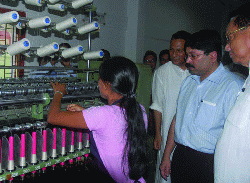Archives
Silk Route to Development
Cheap Chinese silk is gaining substantial market in the region. For want of required facilities for conversion, about 40 to 60 percent of Eri cocoons are transported to other states. In order to support the conversion of Eri to mill spun yarn under the catalytic development programme, the Central Silk Board and Department of Sericulture Government of Assam has provided financial and technical assistance for the establishment of composite silk unit M/S Fabric Plus in Chaygoan near Guwahati. The total estimated cost of the unit is around Rs 5.50 Crores. Assam based Fabric Plus private limited is exporting designer fabrics for fashion and home fashion, including stoles, ties, curtain panels, cushions, corporate gifts to the European and US markets.
The company already has three units and with the commencing of the fourth unit the production will increase to 1, 20,000 liner meters of fabric from 50, 000 liner meters of fabric. The unit will also have the facility of 90,000 metric tones of yarn, 60,000 of which will be Eri and Muga.
Sounding optimistic, Dilip Barooah, Managing Director of the company said that the turnover of the company is around Rs 4 crore annually and with the fourth unit getting commissioned it will increase to 14 crores. “We export 70 percent of the production to the European market and 30 percent to USA.”
The ministry of textiles is also planning to create a brand image for Eri silk to attract global buyers. The ministry has also chalked out plans for increasing the production and showcasing Vanya silk comprising of Tassar, Eri, and Muga internationally.
 Union Minister for textiles, Dayanidhi Maran who was on a one day visit to Assam recently said, “I would urge the business community especially exporters, to create a niche market for Eri silk which I understand is unique in several aspects. It has excellent thermal properties, possessing the warmth of wool and the sheen of silk. Unlike most other silks, Eri is an ‘Ahimsa’ silk as the live pupa is first taken out and the cocoon shell is used for producing spun yarn. These distinctive properties can be exploited to crate a brand image for Eri silk and I am hopeful of a concerted effort in this direction from all stakeholders.”
Union Minister for textiles, Dayanidhi Maran who was on a one day visit to Assam recently said, “I would urge the business community especially exporters, to create a niche market for Eri silk which I understand is unique in several aspects. It has excellent thermal properties, possessing the warmth of wool and the sheen of silk. Unlike most other silks, Eri is an ‘Ahimsa’ silk as the live pupa is first taken out and the cocoon shell is used for producing spun yarn. These distinctive properties can be exploited to crate a brand image for Eri silk and I am hopeful of a concerted effort in this direction from all stakeholders.”
India is the second largest producer of silk in the world. There are four commercially exploited varieties of silk in the world. India is the only country which produces all these four varieties namely Mulberry, Tassar, Eri, and Muga. The rich golden silk is unique to our country; 86 percent of the country’s total Muga production comes from Assam.
About 95 percent of Eri production in the country comes from North East India of which Assam produces about 50 percent. “The ability to produce all four varieties of silk in India constitutes our real strength. This ability must be used as leverage. I realize that it may take us considerable time to give China a run for its money in Mulberry silk but we can and must immediately exploit our premier position in the production of Vanya silk,” Mr. Maran observed.
Mr Maran further said, “The impact of global economic slowdown was felt less in the textile sector due to strong domestic consumption. Our exports are down by 14 percent, however things are looking up. Next month is very crucial for us.”
The ministry has sanctioned a Textile Park in Assam and the setting up of a jute park is in the pipeline. Under the 11th plan, Rs 56.51 crore has been released as central share to the North East for the development of sericulture. Of this, Rs 25 crore has been allocated as Assam’s share. The Eri silk production in the North East has increased by over 37 percent.
The production of Eri silk has gone up from 1485 MT in 2006-07 to 2038 MT in 2008-09 in the country. The total silk production in Assam during 2008-09 was around 1261 MT which includes 1141 MT of Eri Silk, 105 MT of Muga and 15 MT of Mulberry silk. Around two lakh people are employed under the sericulture sector in the North East.

